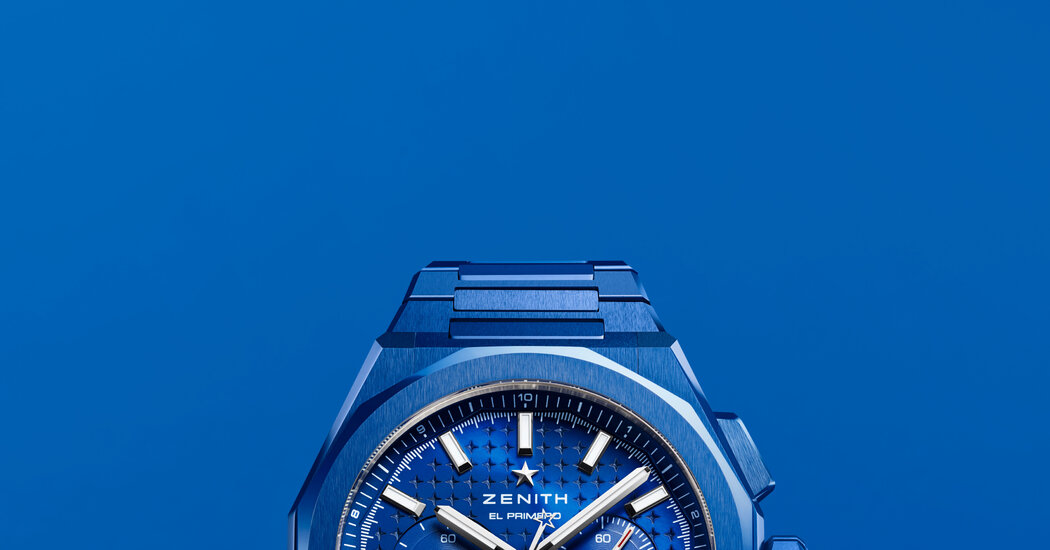This year, Chanel is celebrating the 25 -year anniversary of his J12 watch with what it described as an important technical achievement: the debut of its own ceramic color that lasted five years to develop. A deep midnight blue that borders black and shades shifts, depending on the light, the J12 Bleu, as Chanel calls it, goes beyond the color restrictions of the past.
Chanel, however, is not only in this new territory. Panerai, Audemars Piguet and Zenith have also spent years creating new blue ceramic hues.
The attraction of Blue in Watch Design is hardly new – blue dials that have been printed or even painted by hand have been popular for centuries. As the Pantone Color Institute noticed when the Classic Blue called the color of the year in 2020, Blue conveys ‘calmness, trust and connection’.
Yet the ability to make completely blue cases and bracelets is a relatively recent progress that started with colored PVD coatings (physical vapor deposits) on stainless steel. Later colored technical ceramics were developed – but the first blue tone, used by people like Richard Mille, IWC, Omega and Hublot, was a daring cobalt, the only pigment that was on the market at the time.
Arnaud Chastaingt, the director of the Chanel Watchmaking Creation Studio in Paris, said that although Chanel is known for his black -white color schemes, he was inspired by a few dark blue evening dresses that he had seen years ago in an exhibition, and by the blue of a few jewelry boxes that the house used in 1932.
“They introduced me a lot of blue before I saw the one I loved and knew immediately that it was the perfect blue for Chanel,” he said. “It is a blue close to black, or a black close to blue, depending on how you see it.”
Although the search to develop color variations can be powered by stylistic or aesthetic requirements, working with ceramic presentations is operational challenges. Engineering ceramics is created from inorganic, non -metal powders, usually zirconium oxide. When the powders are mixed with binding agents to set the material, the colors change, making it difficult to make a specific color.
Experts say that maintaining the characteristic qualities of the material such as his scratch resistance, hypoallergenic properties and lightweight feeling, while also perfecting a new color. Success requires extensive research and development, advanced production methods and time -consuming rounds of trial and error.
“When I decided to make a special blue for Chanel, I worked with our ceramic team to understand the complexity,” said Mr. Chastaingt. “You can’t just add color to white ceramics or give color to black – you have to discover a mix of color and properties. I understood that it would be a long process.”
Chanel’s original J12 was released in 2000 in Black Ceramic and then in 2003 in white. A subsequent plan to expand the brand’s expertise in the material led to the final creation of an internal ceramics division. Have developed its own injection molding process over the years. Chanel now makes his own case and bracelet components of patented ceramic powder formulas and compressed cylinders of zirconium oxide powder.
The J12 Bleu collection – introduced on the watches and wonders this month from Geneva – comprises nine iterations. The J12 Bleu 38mm Sapphires watch, for example made in a 100-piece Limited Edition, has a belly set with 46 baguette cut sapphires and dials of 12 intern Sapphire. (155,000 euros; The price of the US dollar is still indefinite).
Chanel said it would take a year to produce the J12 X -ray flash, which is processed from sapphire crystal and accentuated with matching blue sapphires (€ 1.2 million).
Deep
Panerai spent almost three years perfecting the blue of his ceramics, a matte color that has no official name. But unlike Chanel, it does not have its own internal ceramic department, so it had to turn to an external supplier who refused to identify it.
The result was the 300-part 40-millimeter Luminor Quaranta Bitempo Ceramica, which this month was quietly shown to retailers on Watches and Wonders Verwangs this month and is expected to be available for sale in late summer or early autumn. (€ 16,300; $ 16,000 in the United States)
“The first blue they showed me was too clear, too electric,” said Jean-Marc Pontroué, Panerai’s former chief executive of 25 years who recently left the company. “Panerai is really a very black-on-black-black brand.”
The brand started to make watches for the Royal Italian Navy in 1916. Thanks to that marine origin, Mr. Pontroué “wanted a blue that borders Black, a subtle evolution,” he said. “It is a way to offer our customers a choice without being flashy.”
The color development process included many exchanges between Panerai and his zirconium oxide supplier. “There is no pantone color to choose, because making the powder in the finished watch includes binders and chemicals that can change the first color,” said Jérôme Cavadini, Chief Operating Officer of Panerai.
He identified a series of acceptable blues to offer some margin for mistakes, but several prototypes were made, he said, before the supplier reached a shade that Mr Pontroué considered appropriate.
“You always have some surprises when you make ceramics because of the process,” Mr Cavadini said, and noticed that “every attempt required a lot of patience.”
The nocturnal heaven has been a Fount of Inspiration for brands that branch out in blue.
At the beginning of April Audemars Piguet unveiled three deep blue ceramic options in his Royal Oak line. This bleu nuit, now 50 models, take their color student from the 1972 shade who selected the designer Gerald Genta for the first Royal Oak Watch Dial – a shadow self inspired by the ink evening Darkness of the Vallée de Joux, the forested Swiss location of the brand workshop.
Zenith also looked at heaven for Zenith Blue, a ceramic color that made it to preserve his 160 -year anniversary this year. “We wanted to look at the starry sky for a kind of blue that the stars, the Zenith, but was also inspired by our archives,” said Benoit de Clerk, the Chief Executive of the brand. “We have found many blue dials from our past and wanted to push it to the next level.”
The project, under the supervision of Romain Marietta, the main product officer of the brand, was closely collaborated with the powder supplier, case manufacturer and bracelet maker.
It took a long time to create and replicate the exact shade of clear blue, he said. “Every variation can be a nightmare during the assembly of, for example, the bracelet and its many parts, and then for the case and the bracelet to match.”
He noted that inconsistencies could occur as late as during the final process: “When the parts come out of the fungus, they must become microblast to reach the satin finish, and all corners are made by hand. So there may be color variation, even at that stage.”
The development process, Mr Marietta said, lasted about a year, with extra time needed to perfect the finishes and polishing. The brand introduced the new color to watches and wonders in Geneva, and said that three models would be rolled out this year, each as a 160-part limited edition.
They are: the 41-millimeter pilot Big Date Flyback Edition 160 years ($ 15,500), set on debut in April; The 42-Millimeter Tart Skyline Chronograph Edition 160 years ($ 23,800) to arrive in June; And the 41-millimeter Chronomaster Sport Edition 160 years, planned in September.
Was it cost-effective to pour so many research and development efforts into just 480 watches? “Our customers expect innovation from us,” said Mr De Clerck, “and we have to deliver.”





